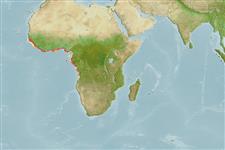>
Eupercaria/misc (Various families in series Eupercaria) >
Sciaenidae (Drums or croakers)
Etymology: Pseudotolithus: Greek, pseudes = false + greek, otos = ear + Greek, lithos = stone (Ref. 45335).
More on author: Bleeker.
Environment: milieu / climate zone / depth range / distribution range
पारिस्थितिकी
समुद्री; स्वच्छ जल, अलवण जल; खारा ड़िमरसल; गहराई सीमा 0 - 160 m (Ref. 3593). Tropical; 12°N - 17°S
Eastern Atlantic: Guinea-Bissau (Ref. 26999) to southern Angola (Ref. 3593, 81656). Possibly also occurring more to the north (Ref. 81656).
आकार / वज़न / Age
Maturity: Lm ? range ? - ? cm
Max length : 60.0 cm TL पुल्लिंग / अलिंग; (Ref. 3593); common length : 35.0 cm TL पुल्लिंग / अलिंग; (Ref. 3593)
Short description
आकृति विज्ञान | मौरफोमैटरिक्स
पृष्ठीय रीढ़ (सम्पूर्ण): 10; पृष्ठीय सौफट रेज़ (सम्पूर्ण): 35-39; गुदा कांटा 2; ऐनल सौफट रेज़: 7. Diagnosis: moderately sized species with an elongate and laterally compressed body; dorsal with 9 (10?) spines in 1st part, second part with 1 spine and 35-39 soft fin rays; second anal spine clearly shorter than first anal fin soft ray, i.e. about half its length, and robust; pectoral fins long, 23.3-27.3% SL; caudal fin S-shaped; mouth inferior almost horizontal; maxilla extending to posterior half of eye; 7-9/1/4-7 (total 13-18) gill rakers on 1st gill arch; lower part of 1st gill arch with 2-6 reduced additional gill rakers, upper part with 0-2 reduced additional ones; gill rakers moderately long and fine, but shorter than the gill filament at angle between lower and upper part of gill arch; preopercular edge feebly denticulated but never with spines; eyes rather small, 4.6-5.4 times in HL, but this character is difficult to use for identification because of allometry (Ref. 81656).
Coloration: generally very dark, but occasionally pale silver often with faint dark brown oblique lines on sides; ventral side of head and belly yellowish; all fins greyish to very dark brown, black (Ref. 81656).
Occurs in coastal waters from the shore to about 70 m over mud bottom, but moves to deeper water. Also found in estuaries and coastal lagoons (Ref. 3593, 81656). Mainly feeds on benthic invertebrates (Ref. 81656).
Life cycle and mating behavior
परिपक्व अवधि | पुनरुत्पत्ति | मछलीऔ का अंडे देना | अंडे | Fecundity | लार्वा
Chao, L.N. and E. Trewavas, 1990. Sciaenidae. p. 813-826. In J.C. Quero, J.C. Hureau, C. Karrer, A. Post and L. Saldanha (eds.) Check-list of the fishes the eastern tropical Atlantic (CLOFETA). JNICT, Lisbon; SEI, Paris; and UNESCO, Paris. Vol. 2. (Ref. 3593)
IUCN Red List Status (Ref. 130435)
Threat to humans
Harmless
Human uses
मात्स्यिकी: व्यापारिक
अधिक जानकारी
आम नामउपशब्दचपायचयपरभक्षीईकोटोकसीकोलौजीपुनरुत्पत्तिपरिपक्व अवधिमछलीऔ का अंडे देनाSpawning aggregationFecundityअंडेEgg development
Age/Sizeबाढ़Length-weightLength-lengthLength-frequenciesमौरफोमैटरिक्सआकृति विज्ञानलार्वालारवल गतिकीभर्तीबहुतायतBRUVS
संदर्भजलीयकृषिजलीयकृषि रूपरेखाखींचआनुवंशिकीElectrophoresesहैरेटिबिलटीबीमारीप्रक्रमणNutrientsMass conversion
सहयोगीयोतस्वीरेStamps, Coins Misc.ध्वनिसिगुयटिरारफ्तारतैरने के प्रकारगिल क्षेत्रOtolithsदिमागदृष्टि
साधन
Special reports
Download XML
इंटरनेट स्रोत
Estimates based on models
Preferred temperature (Ref.
123201): 19.2 - 27.9, mean 26 °C (based on 102 cells).
Phylogenetic diversity index (Ref.
82804): PD
50 = 0.5156 [Uniqueness, from 0.5 = low to 2.0 = high].
Bayesian length-weight: a=0.00575 (0.00278 - 0.01190), b=3.11 (2.93 - 3.29), in cm total length, based on LWR estimates for this (Sub)family-body shape (Ref.
93245).
Trophic level (Ref.
69278): 3.6 ±0.6 se; based on size and trophs of closest relatives
लौटाव (Ref.
120179): माध्यम, न्यूनतम जनसंख्या दुगनी होने का समय 1.4 - 4.4 वर्ष। (Preliminary K or Fecundity.).
Fishing Vulnerability (Ref.
59153): Moderate vulnerability (44 of 100).
Nutrients (Ref.
124155): Calcium = 114 [62, 210] mg/100g; Iron = 0.872 [0.469, 1.499] mg/100g; Protein = 18.7 [17.5, 19.8] %; Omega3 = 0.156 [0.078, 0.287] g/100g; Selenium = 75.1 [39.5, 144.8] μg/100g; VitaminA = 15.5 [6.1, 43.4] μg/100g; Zinc = 1.15 [0.82, 1.64] mg/100g (wet weight);
